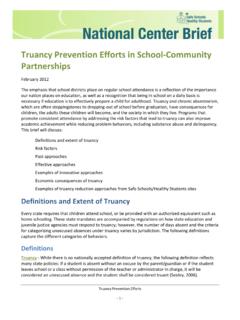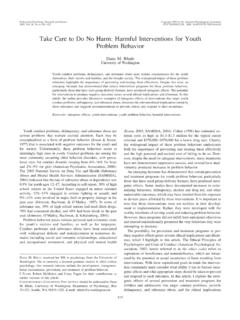Transcription of Introduction to Crime Prevention - Jones & Bartlett Learning
1 Introduction to Crime PreventionDavid A. MackeyPlymouth State UniversityInTRoduCTIon _____On Sunday, October 4, 2009, the peaceful tranquility of Mont Vernon, New Hampshire, was shat-tered after police responded to an open 911 call with no one on the telephone line. Initial news re-ports indicated that 42-year-old Kimberly Cates had been murdered and her 11-year-old daughter severely injured during the course of an early morning home invasion. The mother and daughter had been attacked with a machete during a burglary-turned-murder. Tips immediately began to surface, leading the police to investigate four local youths: Steven Spader, Christopher Gribble, William Marks, and Quinn Glover. According to the police affi davit (State of New Hampshire, 2009), Gribble stabbed Jamie Cates in the right lung and then tried to stab her in the heart through her back. Steven Spader mortally wounded Kimberly Cates. The four assailants intended to kill both mother and daughter to eliminate witnesses to the Spader was the fi rst of the four individuals to stand trial for the murder.
2 On his 19th birthday, Spader received a sentence of life in prison for the murder of Kimberly Cates. With media cameras capturing the moment, Spader asked his attorney if the jury would sing Happy Birthday to him (WMUR-TV, 2010). In a separate trial, Christopher Gribble received a life sentence follow-ing his unsuccessful attempt to use the insanity defense. As for the other defendants, Quinn Glover would be sentenced to 20 40 years in prison for burglary, burglary conspiracy, and robbery, and William Marks received a 30 60-year sentence for fi rst-degree assault, burglary conspiracy, and murder conspiracy. Autumn Savoy, a fi fth suspect subsequently arrested for hiding evidence and providing alibis for the other four, received a 5 12-year prison sentence and a suspended 7-year term after his release when he pled guilty to conspiracy to hinder apprehension and two counts of hindering apprehension (Associated Press, 2011).
3 The Mont Vernon murders shattered the tranquility of the local area. Residents unaccus-tomed to Crime faced a range of emotions, from shock and fear to anger. Some communities ex-perience Crime , whether property, violent, or so-called victimless crimes, on a regular basis, and criminal activities and violence often follow a familiar pattern. According to the Federal Bureau of Investigation s annual Crime statistics for New Hampshire (Federal Bureau of Investigation, 2009a), Kimberly and Jamie Cates were the victims of Mont Vernon s only two violent crimes in the entire year. Mont Vernon, a town of just over 2,400 people, is located in the safest state in the nation, ac-cording to the FBI s Uniform Crime 111/1/11 9:15 AM Jones & Bartlett Learning , LLC. NOT FOR SALE OR DISTRIBUTION. Jones & Bartlett Learning , LLCNOT FOR SALE OR DISTRIBUTION Jones & Bartlett Learning , LLCNOT FOR SALE OR DISTRIBUTION Jones & Bartlett Learning , LLCNOT FOR SALE OR DISTRIBUTION Jones & Bartlett Learning , LLCNOT FOR SALE OR DISTRIBUTION Jones & Bartlett Learning , LLCNOT FOR SALE OR DISTRIBUTION Jones & Bartlett Learning , LLCNOT FOR SALE OR DISTRIBUTION Jones & Bartlett Learning , LLCNOT FOR SALE OR DISTRIBUTION Jones & Bartlett Learning , LLCNOT FOR SALE OR DISTRIBUTION Jones & Bartlett Learning , LLCNOT FOR SALE OR DISTRIBUTION Jones & Bartlett Learning , LLCNOT FOR SALE OR DISTRIBUTION Jones & Bartlett Learning , LLCNOT FOR SALE OR DISTRIBUTION Jones & Bartlett Learning , LLCNOT FOR SALE OR DISTRIBUTION Jones & Bartlett Learning , LLCNOT FOR SALE OR DISTRIBUTION Jones & Bartlett Learning , LLCNOT FOR SALE OR DISTRIBUTION Jones & Bartlett Learning , LLCNOT FOR SALE OR DISTRIBUTION Jones & Bartlett Learning .
4 LLCNOT FOR SALE OR DISTRIBUTION Jones & Bartlett Learning , LLCNOT FOR SALE OR DISTRIBUTION Jones & Bartlett Learning , LLCNOT FOR SALE OR DISTRIBUTION Jones & Bartlett Learning , LLCNOT FOR SALE OR DISTRIBUTION Jones & Bartlett Learning , LLCNOT FOR SALE OR DISTRIBUTION2 CHAPTER 1 / Introduction to Crime PreventionCosTs of Crime _____The costs of Crime to society are staggering, despite the fact that the United States has experienced a substantial decline in the overall amount of Crime since 1990. The FBI notes that from 2000 to 2009, the nation s violent Crime rate dropped (Federal Bureau of Investigation, 2009b) and declined 40% from 1990 to 2009 (Federal Bureau of Investigation, 2009c). Results from the 2009 National Crime Victimization Survey (NCVS) indicate that criminal victimization is at a historic low point since the inception of this victimization measurement survey (Truman & Rand, 2010). Results from the NCVS indicated specific declines of 39% from 2000 to 2009 for the rate of violent Crime and a decline of 29% for the rate of property Crime (see Table 1-1).
5 Nevertheless, Crime Prevention remains a central issue for the criminal justice system as well as society as a whole. In 2009, the Uniform Crime Reports index of offenses (Federal Bureau of Investigation, 2009c) indicated that more than million violent crimes and million property crimes have been these decreases in Crime might imply that the costs of criminal justice have decreased proportionately, such is not the case. Data from 2007 (Bureau of Justice Statistics, 2011) show TTAblE 1-1 Rates of Criminal Victimization and Percentage Change, by Type of Crime , between 2000 and 2009 Type of CrimeVictimization RatesPercentage Change 2000 200920002009 Violent Crime * Rape/sexual assault * Robbery * Assault * Aggravated * Simple *Personal theft *Property * Household burglary * Motor vehicle theft * *Note. The total population age 12 or older was 226,804,610 in 2000 and 254,105,610 in 2009.
6 The total number of households in 2000 was 108,352,960 and 122,327,660 in 2009. An asterisk (*) indicates that difference is significant at the 95%-confidence level. Victimization rates are per 1,000 persons age 12 or older for violent Crime or per 1,000 households for property Crime . Differences between the annual rates shown do not take into account changes that may have occurred during interim years. Percent change calculated on unrounded estimates. Violent Crime excludes murder because the NCVS is based on interviews with victims and therefore cannot measure murder. Personal theft includes pocket picking, completed purse snatching, and attempted purse from: Truman, J. L., & M. R. Rand, 2010. Criminal Victimization, 2009. Bureau of Justice Statistics, Department of Justice, p. 2. Retrieved from 211/1/11 9:15 AM Jones & Bartlett Learning , LLC. NOT FOR SALE OR DISTRIBUTION. Jones & Bartlett Learning , LLCNOT FOR SALE OR DISTRIBUTION Jones & Bartlett Learning , LLCNOT FOR SALE OR DISTRIBUTION Jones & Bartlett Learning , LLCNOT FOR SALE OR DISTRIBUTION Jones & Bartlett Learning , LLCNOT FOR SALE OR DISTRIBUTION Jones & Bartlett Learning , LLCNOT FOR SALE OR DISTRIBUTION Jones & Bartlett Learning , LLCNOT FOR SALE OR DISTRIBUTION Jones & Bartlett Learning , LLCNOT FOR SALE OR DISTRIBUTION Jones & Bartlett Learning , LLCNOT FOR SALE OR DISTRIBUTION Jones & Bartlett Learning , LLCNOT FOR SALE OR DISTRIBUTION Jones & Bartlett Learning , LLCNOT FOR SALE OR DISTRIBUTION Jones & Bartlett Learning , LLCNOT FOR SALE OR DISTRIBUTION Jones & Bartlett Learning , LLCNOT FOR SALE OR DISTRIBUTION Jones & Bartlett Learning , LLCNOT FOR SALE OR DISTRIBUTION Jones & Bartlett Learning , LLCNOT FOR SALE OR DISTRIBUTION Jones & Bartlett Learning , LLCNOT FOR SALE OR DISTRIBUTION Jones & Bartlett Learning .
7 LLCNOT FOR SALE OR DISTRIBUTION Jones & Bartlett Learning , LLCNOT FOR SALE OR DISTRIBUTION Jones & Bartlett Learning , LLCNOT FOR SALE OR DISTRIBUTION Jones & Bartlett Learning , LLCNOT FOR SALE OR DISTRIBUTION Jones & Bartlett Learning , LLCNOT FOR SALE OR DISTRIBUTIONT heoretical foundations of Crime Prevention3that the United States annually spent an estimated $230 billion on criminal justice. This figure includes only costs associated with police, courts, and corrections; vast additional funds go toward homeland security. In addition to the costs of criminal justice at the federal, state, county, and local levels, there are costs borne by the victim, whether the victim is an individual or a business entity. Some monetary aspects of criminal victimization are more easily counted than others. For instance, Maguire (2003) notes the average loss in 2002 for a robbery was $1,281, for a purse snatching, $332, and for a bicycle theft, $257.
8 The costs of Crime are both direct and indirect and include money spent on private security and loss Prevention , alarm monitoring, medical costs, lost wages/lost work days, stolen property, increased security or target hardening measures, and increased product costs due to shoplifting and pilferage. Other costs include incarceration and those that are more difficult to quantify, such as the associated impact on prisoners families and children, subsequent public as-sistance for those families, and even lost tax revenue that might have been generated had individuals been working instead of serving bears the costs of Crime and Crime Prevention in both the public and the private sectors. In fact, private security now accounts for more spending and more personnel than tradi-tional public policing. The Bureau of Labor Statistics (2011) notes that there were approxi-mately 884,000 persons employed as police or detectives in 2008, while private security employed million individuals.
9 This gap favoring private sector security is projected to increase even fur-ther. The Bureau of Labor Statistics notes that while the number of policing jobs is expected to increase 10% by 2018, private security jobs are expected to increase by 14% during the same pe-riod ( Bureau of Labor Statistics, 2011). As these statistics suggest, Crime Prevention efforts benefit when private security and public law enforcement agencies collaborate. For instance, the Law Enforcement Private Security Consortium (2009) emphasizes collaboration in the areas of homeland security, infrastructure protection, special event security, transportation security, and financial Crime investigation. Collaboration in these areas provides both public and private sec-tor Crime Prevention entities with additional resources and deeper knowledge of specific areas, such as power-generating facilities, manufacturing plants, and even schools. The consortium also notes specific examples of collaboration in which private security provides law enforcement with access to closed-circuit television capabilities, thereby expanding the resources available to law enforcement without forcing taxpayers to support the purchase, installation, and maintenance of such security foundATIons of Crime Prevention _____Several theoretical models, drawn from both the public health field and criminology, are directly applicable to the Prevention of Crime .
10 By applying these theoretical models, researchers and policy makers can plan and implement intervention programs, that is, programs to prevent Crime . Having a sound theoretical model helps researchers evaluate such programs and determine the impact of the intervention on the targeted problem. Farrington (2000) notes the recent trend of identifying key variables for delinquency Prevention during the course of longitudinal studies that policy makers can then use when implementing delinquency Prevention programs. Ideally, this connection would produce a synergy of policy implementation and delivery, which can then be tested empirically. Information from those tests can then help officials improve the interven-tion 311/1/11 9:15 AM Jones & Bartlett Learning , LLC. NOT FOR SALE OR DISTRIBUTION. Jones & Bartlett Learning , LLCNOT FOR SALE OR DISTRIBUTION Jones & Bartlett Learning , LLCNOT FOR SALE OR DISTRIBUTION Jones & Bartlett Learning , LLCNOT FOR SALE OR DISTRIBUTION Jones & Bartlett Learning , LLCNOT FOR SALE OR DISTRIBUTION Jones & Bartlett Learning , LLCNOT FOR SALE OR DISTRIBUTION Jones & Bartlett Learning , LLCNOT FOR SALE OR DISTRIBUTION Jones & Bartlett Learning , LLCNOT FOR SALE OR DISTRIBUTION Jones & Bartlett Learning , LLCNOT FOR SALE OR DISTRIBUTION Jones & Bartlett Learning , LLCNOT FOR SALE OR DISTRIBUTION Jones & Bartlett Learning , LLCNOT FOR SALE OR DISTRIBUTION Jones & Bartlett Learning , LLCNOT FOR SALE OR DISTRIBUTION Jones & Bartlett Learning , LLCNOT FOR SALE OR DISTRIBUTION Jones & Bartlett Learning , LLCNOT FOR SALE OR DISTRIBUTION Jones & Bartlett Learning , LLCNOT FOR SALE OR DISTRIBUTION Jones & Bartlett Learning , LLCNOT FOR SALE OR DISTRIBUTION Jones & Bartlett Learning .


















